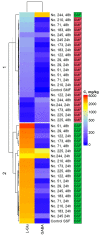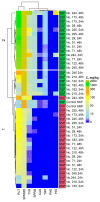Changes in Spirulina's Physical and Chemical Properties during Submerged and Solid-State Lacto-Fermentation
- PMID: 36668894
- PMCID: PMC9862786
- DOI: 10.3390/toxins15010075
Changes in Spirulina's Physical and Chemical Properties during Submerged and Solid-State Lacto-Fermentation
Abstract
The aim of this study was to select a lactic acid bacteria (LAB) strain for bio-conversion of Spirulina, a cyanobacteria ("blue-green algae"), into an ingredient with a high concentration of gamma-aminobutyric acid (GABA) for human and animal nutrition. For this purpose, ten different LAB strains and two different fermentation conditions (SMF (submerged) and SSF (solid state fermentation)) were tested. In addition, the concentrations of fatty acids (FA) and biogenic amines (BA) in Spirulina samples were evaluated. It was established that Spirulina is a suitable substrate for fermentation, and the lowest pH value (4.10) was obtained in the 48 h SSF with Levilactobacillus brevis. The main FA in Spirulina were methyl palmitate, methyl linoleate and gamma-linolenic acid methyl ester. Fermentation conditions were a key factor toward glutamic acid concentration in Spirulina, and the highest concentration of GABA (2395.9 mg/kg) was found in 48 h SSF with Lacticaseibacillus paracasei samples. However, a significant correlation was found between BA and GABA concentrations, and the main BA in fermented Spirulina samples were putrescine and spermidine. Finally, the samples in which the highest GABA concentrations were found also displayed the highest content of BA. For this reason, not only the concentration of functional compounds in the end-product must be controlled, but also non-desirable substances, because both of these compounds are produced through similar metabolic pathways of the decarboxylation of amino acids.
Keywords: Spirulina; biogenic amines; fermentation; gamma-aminobutyric acid; lactic acid bacteria.
Conflict of interest statement
The authors declare no conflict of interest.
Figures






References
Publication types
MeSH terms
Substances
LinkOut - more resources
Full Text Sources
Miscellaneous

